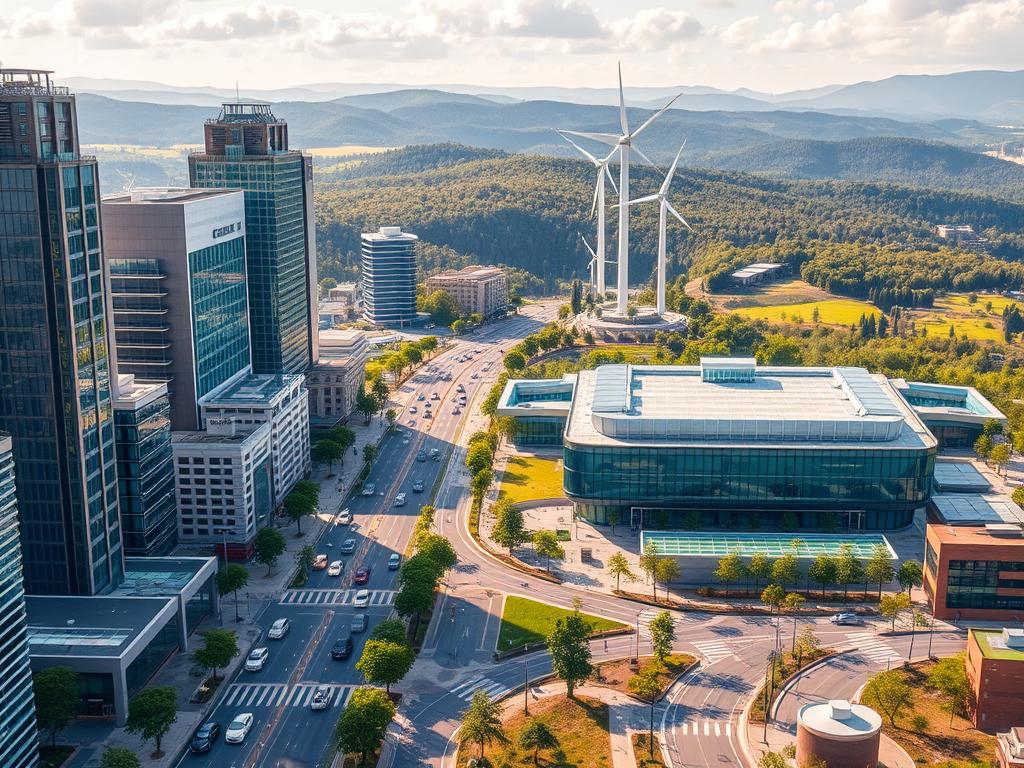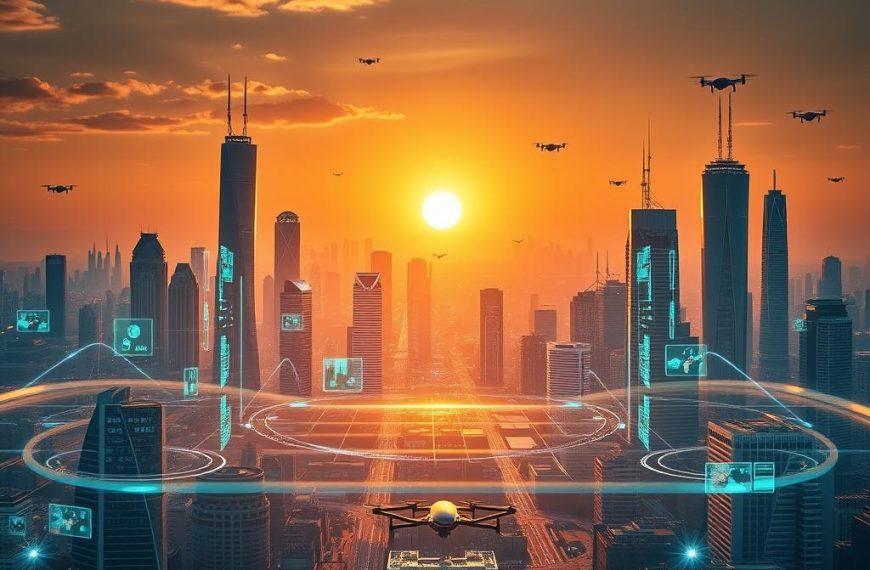Eco-friendly innovations are transforming how we tackle environmental challenges. In 2024, these technologies offer powerful solutions to critical global issues. They’re revolutionising industries with unprecedented speed and innovation.
Green solutions are driving changes in energy, transport, and resource management. Solar power is set to dominate renewable energy by 2030. This shift signals a move towards cleaner power generation.
Climate change requires bold tech interventions. Sustainable technologies provide hope through adaptive strategies. These reduce carbon emissions and boost energy efficiency. They also create more resilient infrastructure for future generations.
Electric vehicles could make up 30% of new car sales by 2030. Advanced water systems might provide clean water for over 2 billion people. These innovations offer a comprehensive approach to global sustainability challenges.
Businesses, governments, and innovators see the value in sustainable tech. They recognise it’s not just good for the planet. It’s also an economically viable path to a greener future.
The Evolution of Renewable Energy Technologies
Renewable energy has transformed remarkably over the past decade. Global installed capacity has nearly doubled, reaching 13.5 TWh. Solar photovoltaic (PV) energy has grown by 37% annually between 1990 and 2018.
Renewable technologies have made significant strides in global electricity generation. In 2019, they accounted for 13.4% of global electricity production, up from 5.9% in 2009. New renewable installations represented 78% of all new capacity in 2019.
Solar Photovoltaics and Advanced Storage Solutions
Solar power has seen unprecedented innovation. Total installed capacity soared from 41.5 GW in 2010 to 584.8 GW in 2020. Key breakthroughs include perovskite cells, transparent panels, and bifacial panels.
- Perovskite solar cells
- Transparent solar panels
- Bifacial solar panels
- Advanced energy storage systems
Machine learning has sped up solar cell research. It’s reduced material classification time from hours to minutes. Researchers can now identify promising materials with remarkable speed and precision.
Wind Energy Innovations and Offshore Developments
Wind energy has grown at an annual rate of 23% between 1990 and 2018. Offshore wind developments have captured global attention. They offer vast potential for clean energy generation.
Tidal and Wave Energy Systems
Tidal and wave energy systems represent the next frontier of sustainable power. These innovative solutions promise to diversify our renewable energy portfolio. They aim to reduce dependence on fossil fuels.
Every hour, an estimated 430 quintillion joules of solar energy reaches the Earth – equivalent to one year’s global energy consumption.
What Are Some Sustainable Technologies Transforming Transportation?
The transportation sector faces a crucial challenge in reducing global carbon emissions. Sustainable transport technologies are changing how we move. These innovations offer clever ways to lessen our impact on the environment.
Electric vehicles (EVs) are a key part of green mobility. Battery technology is improving fast, making EVs more practical and affordable. This shift helps cut greenhouse gas emissions from transport.
- Battery Electric Vehicles (BEVs) demonstrate lower lifecycle emissions
- Global battery production costs are decreasing
- Charging infrastructure continues to expand
Renewable diesel is another breakthrough in sustainable transport. It’s made through hydroprocessing and cuts greenhouse gases by over 50%. This fuel works with existing infrastructure, making it an easy switch.
Green transport tech goes beyond just cutting emissions. It’s reshaping our whole approach to getting around. New ideas like hydrogen fuel cells are making transport greener.
Smart public transit systems are also part of this eco-friendly future. These innovations are making travel more efficient and environmentally friendly.
The transport sector accounts for around 15% of total global greenhouse gas emissions, making technological innovation crucial.
Investing in sustainable transport could bring big rewards. By 2050, yearly returns might top US$1 trillion. This shift isn’t just good for the planet.
It’s also a chance to boost the economy. Green mobility solutions offer both environmental and financial benefits.
Smart Agriculture and Water Conservation Solutions
Modern farming faces unique challenges in resource management and sustainability. Smart technologies are changing how farmers grow crops and conserve water. These innovations promote better environmental stewardship.
Agriculture uses about 70% of global freshwater. This makes innovative water management crucial for sustainable food production. New technology is quickly changing traditional farming methods.
Precision Farming and IoT Integration
IoT in agriculture optimises resources like never before. Farmers now use advanced tech to make smart choices. These data-driven decisions boost crop yields and promote sustainability.
- Soil moisture sensors reduce water consumption by 20-50%
- Satellite imagery can increase crop productivity by up to 15%
- Precision agriculture technologies potentially boost crop yields by 10-30%
Advanced Irrigation Systems
Water-efficient irrigation is changing farm water management. New solutions help farmers use resources wisely. These methods also reduce environmental impact.
| Irrigation Technology | Water Savings |
|---|---|
| Drip Irrigation | 30-50% reduction |
| Micro-sprinkler Systems | 30% less water usage |
| AI-powered Irrigation | 20-40% water savings |
Resource Optimisation Technologies
New farm tech allows for incredible efficiency. Water Smart Agriculture (WaSA) methods can double farmers’ incomes. This is achieved through year-round planting and harvesting.
By 2050, farmers will need to produce 70% more food to feed a projected global population of 9.7 billion.
These fresh approaches boost productivity significantly. They also support global food security and environmental sustainability.
Green Building and Waste Management Innovations
Sustainable construction is changing the built environment with innovative materials. These new approaches reduce carbon emissions and environmental impact. Advanced green building technologies now create structures that fight climate challenges.
Bio-based materials like bamboo and cork absorb carbon effectively. Recycled steel and plastic lumber reduce reliance on virgin materials. This promotes a circular economy in construction.
Energy-efficient components like Insulated Concrete Forms (ICFs) cut energy use by half. Aerogel insulation provides excellent thermal resistance. These innovations significantly reduce heating and cooling needs.
Waste-to-energy conversion turns rubbish into valuable resources. This technology reduces landfill burdens and creates sustainable energy sources. Green roof systems can halve air conditioning needs in summer.
Smart building technologies optimise energy management effectively. Net-zero energy buildings produce as much energy as they use. This approach transforms sustainable urban development.
The future of construction prioritises environmental responsibility. Architects and developers can create buildings that contribute to global sustainability efforts. These innovations minimise ecological impact while maximising efficiency.















